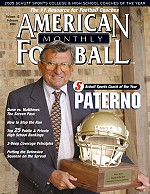AMERICAN FOOTBALL MONTHLY THE #1 RESOURCE FOR FOOTBALL COACHES
Article CategoriesAFM Magazine
|
Three Deep Coverage Principlesby: Mark Dantonio© More from this issue College football programs across the country are currently in a huge transition period, both offensively and defensively. Offensively, teams are spreading the field with receivers, creating run and pass situations that require defenders to tackle in space. Defensively, zone pressure and eight man front defenses are being designed to create pressure and eliminate an opposing offense’s run game. In doing this, we are seeing a shift back to the three deep coverage concept used so regularly throughout the history of college football. Like many of you, my exposure to three deep coverages is quite extensive, having played and coached in its environment for the majority of my football life. My new appreciation and perspective regarding the base thoughts, teaching progression and consistencies are a direct result of working for Nick Saban at Mi....The full article can only be seen by subscribers. Subscribe today!
|
|
|||||||
| HOME |
MAGAZINE |
SUBSCRIBE | ONLINE COLUMNISTS | COACHING VIDEOS |
Copyright 2025, AmericanFootballMonthly.com
All Rights Reserved





